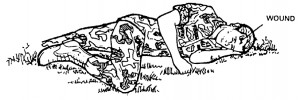After treating the casualty for any immediate life-threatening conditions, evaluate the casualty’s condition and position him appropriately.
The evaluation includes checking the casualty’s level of consciousness using the AVPU method (alert, responds to verbal commands, responds to pain, unresponsive). The same rules are used to position a casualty after his open head wound has been dressed.
a. If the casualty has a suspected spinal fracture or severe head injury, do not move him unless it is necessary. Keep the casualty as immobile as possible while you dress his wound.
b. If the casualty is having convulsions (involuntary muscle movements such as uncontrolled jerking or shaking), gently support his head and neck to prevent the casualty from accidentally injuring himself. Do not try to forcefully hold his arms and legs. Trying to “pin down” jerking limbs will probably cause additional injury.
c. If the casualty is choking, nauseous, vomiting, or bleeding from his mouth, position the casualty on his side (figure 5-1) in the recovery position. This position is used since it promotes drainage and helps to maintain an open airway. Place the casualty on the side opposite that of the wound (wound away from the ground). Also place the casualty in this position if you must leave him.

